Ange Postecoglou’s Celtic are on the cusp of another domestic treble having sown up their 11th Scottish Premiership title in 12 years at Tynecastle yesterday. With the League Cup already won, only Championship side Inverness Caledonian Thistle stand in the way of Celtic’s 41st Scottish Cup and another season of complete dominance in Scotland.
A trademark of the Glasgow giant’s game model, and fundamental to their success, is how they build up from the back. Even when competing against the very best in the UEFA Champions League, Celtic are relentless in playing their way regardless of the opposition.
This tactical analysis will analyse the key principles and tactics involved in Celtic’s build-up play. The team’s shape during the build-up phase and the role of individuals within that shape will be analysed too. Included in this analysis will be the different tactics Celtic have faced, the solutions they came up with and how coaches can implement this tactical theory.
Joe Hart and quick restarts
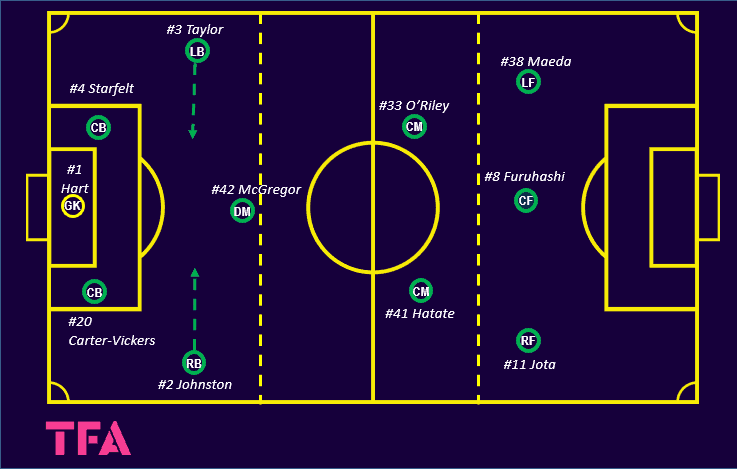
A staple and well-documented element of Postecoglou’s time at Celtic has been the intensity of their play. Joe Hart is often the catalyst for this through his quick restarts. He plays a very active role in all phases of the build-up by creating angles to receive and moving the ball at a fast tempo. Whilst his calmness on the ball is the key to Celtic being able to play out, the speed at which he launches attacks is often the most impactful part of his in-possession play.

The above image shows Hart, immediately after making a save, running beyond his defending players before releasing the ball. The speed at which Hart chooses the correct pass, usually rolling it to the nearest player’s feet, means Celtic are on the attack well before the opposition can get themselves set up defensively. This example of a quick transition led to a four-on-four in the opposition’s half.
Hart is also extremely quick in getting goal-kicks back into play. Aided heavily by the obviously well-instructed ball boys at Celtic Park, Hart almost immediately has a new ball in his hand as soon as one leaves the pitch. Usually, Hart places the ball and plays out to the opposite side from where the ball has gone out.
These restarts appear as a very simple and easily implementable tactic at any level. However simple, it is extremely effective and rarely carried out at this speed and consistency. This is particularly useful when playing domestically where Celtic often face defensive-minded sides where having space to attack is only on offer from transitions.
Inverted full-backs
“There’s no point playing football a certain way and then, when you get the opportunity to measure it against the best, you shy away from it,” said Postecoglou, prior to Celtic’s Champions League match at Real Madrid.
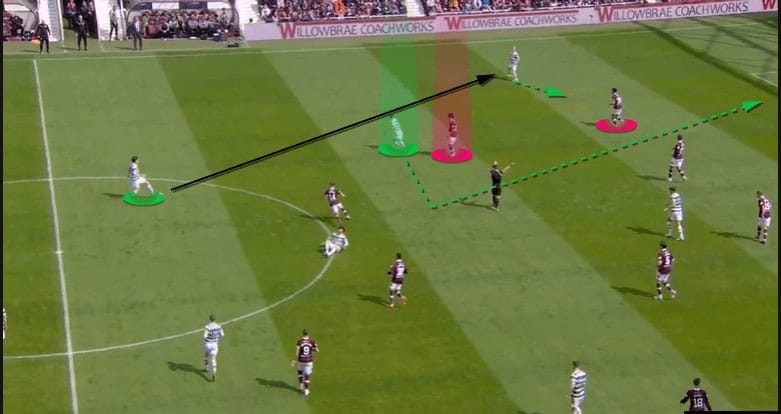
Postecoglou’s side, although they adapt based on the opposition’s pressing structure, have the same key principles whether playing domestically or against the very best in the Champions League. One of these principles is the use of inverted full-backs.
The positioning of Celtic’s full-backs allows them to initially overload central areas to provide passing options when the ball is in their defensive third and as security if possession is lost. When the ball progresses up the pitch, they can attack the box in the half-spaces from areas that make them very hard to mark. They can also still offer themselves for overlaps in the final third from this position.
In the above image, Hearts have dropped into a mid-to-low block. With the ball travelling from Celtic’s right to left, the left-back, #3 Greg Taylor, remains in the inverted position. By standing still, Taylor is occupying Hearts’ widest midfielder and preventing him from screening or intercepting a pass into Celtic’s winger, #38 Daizen Maeda.
Without touching the ball, Taylor has helped create a one-on-one for Maeda with Hearts’ right-back. On this occasion, the right-back remains in his shape, allowing Maeda to receive unopposed. With the quality and dribbling attributes of Celtic’s wingers, this is an ideal scenario which allows them to dribble at full-backs and deliver crosses into the box.
As the ball was played into Maede, and Hearts’ wide midfielder had his eye on the ball, Taylor made a blind side move away from the defending player. Taylor then sprinted into the box (shown in the image). If the full-back had jumped, which often happens, Celtic could have combined to play around the pressing player or slide in Taylor in inside the box.
Build-up pattern and bounce passes
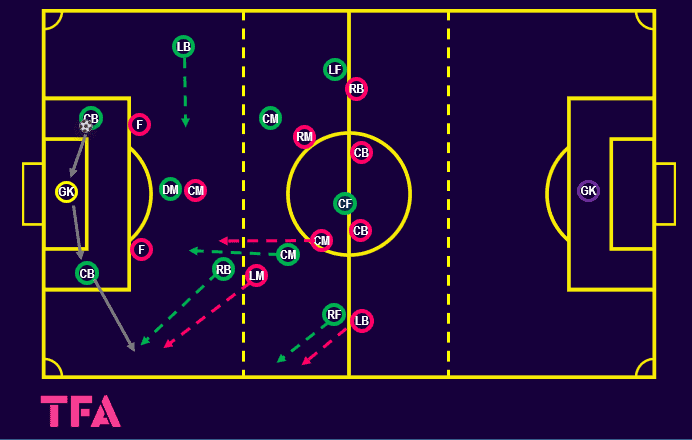
This example of a build-up pattern used by Celtic whilst being high-pressed includes the use of inverted full-backs and, another common theme of theirs, the bounce pass. This play began with a goal-kick passed to the left centre-back inside the box. When the ball went left, Celtic’s right-back took up an inverted position.
On this occasion, when the ball was then switched via Hart to the right centre-back, the right-back made a run to the side of the box to receive. Because of his initial positioning, in front of the opposition’s left midfielder, and his sharp movement, the midfielder followed him towards the ball. Simultaneously, Celtic’s ball-near central midfielder ran towards his centre-back, bringing the opposition’s ball-near central midfielder with him.
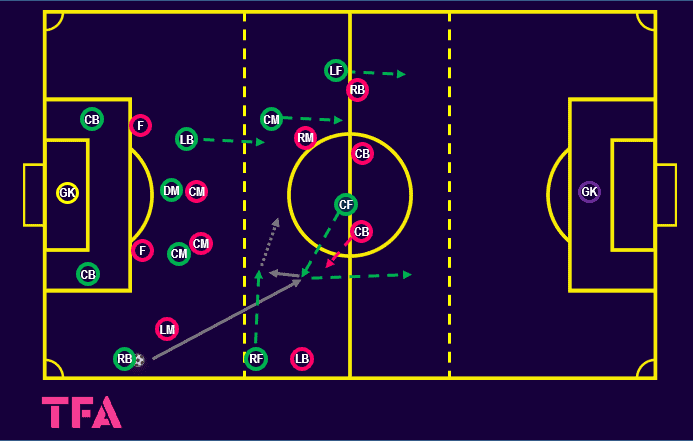
The synchronised movements of the right-back and central midfielder created a large hole beyond the opposition’s midfield line. This opened a passing lane for the central forward who ran from the blind side of the ball-near centre-back towards the ball. The right-back, whose movement was quick enough to allow him to receive facing forward, played into his forwards’ feet.
As the ball was travelling to the forward, Celtic’s winger ran across the face of his teammate to receive a lay-off. The winger continued in the same direction with the ball at his feet with the centre of the pitch now completely empty. From this position, Celtic had created vast options to play forward with their movements, having pulled the opposition backline out of position.
Every player in this phase of play passed the ball facing the direction in which they received it. This meant no blind passes that could be intercepted and no time wasted turning on the ball. The sharp, well-timed movements of the receiving player do not allow the nearest opposition player time to think. Without the time to pass his man on, these movements almost inevitably lead to the opponent jumping. Celtic then exploit the space created behind him.
Coaching Celtic’s build-up play
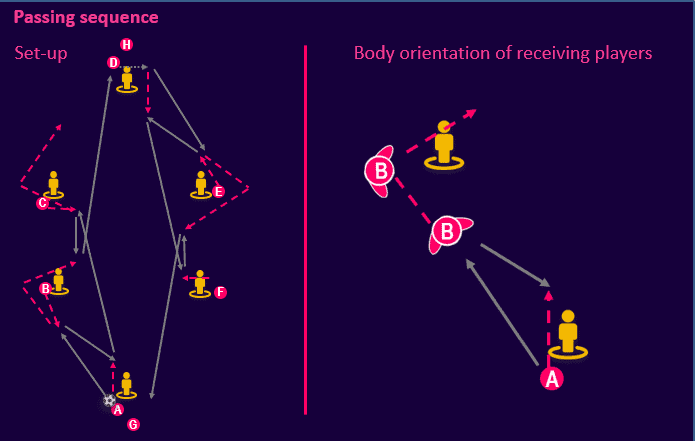
This passing sequence aims to work on the bounce pass, with players being coached on their body orientation, angles to receive the ball and their weight of passes. It also works on the timings of their movement to replicate those described in the previous section. This drill can be incorporated as part of the warm-up to lead into the opposed sections of the training session.
The first pass should be a slow lay-off into player B. B could represent an inverted fullback or a midfielder receiving the ball with his back to goal. The weight of the pass and the closed-off body shape is designed to encourage the opposition to press the receiving player.
Player B sets the ball back to player A with a weighted pass that allows A to step onto the ball and play a firm, line-breaking pass to C. Player C’s trigger to move is when B sets the ball back. This should allow him to receive the ball on the move and therefore, in a game, be harder to mark. Both player A’s and player B’s movements should be made from the blind side of the defending player (represented by a mannequin).
Player C then lays off to player B and spins off as B plays into player D. As shown on the diagram, players should spin off opening their body in the ball’s direction. This allows them to keep their eye on the ball and the rest of the play.
When the ball reaches D, the sequence continues down the opposite side. The rotation of the players is A to B to C etc. Two balls can be introduced to keep the intensity of the exercise.
Coaches should emphasise the speed of play and the triggers and timings of runs. No player should be receiving the ball standing still to make the passing sequence game relevant. If a progression is required, a one-two can be added between players C and D.
4 + 4 Vs 2 Rondo
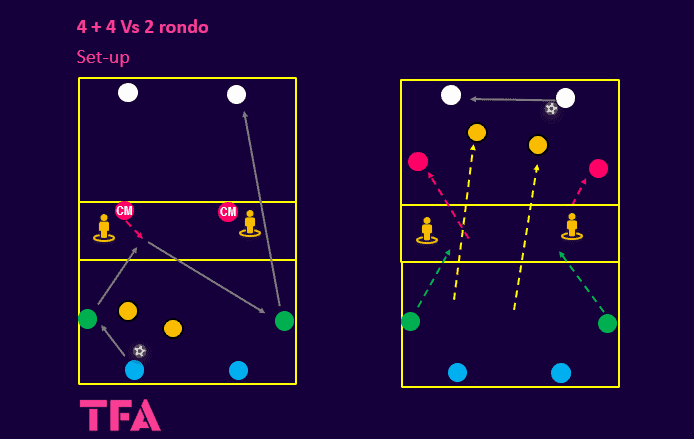
In this rondo, five teams of two are created with one of the five teams defending. The aim of the drill is for the four players in the first box to complete five passes before playing into the two pink players who represent midfielders. The pink players must then play backwards into a supporting player from the first box who then plays to the opposite side.
If the in-possession team are successful, the defending team, shown as yellow in the diagram, remain as the defenders and have to press in the opposite box. The team that switches the ball transfer to the middle box as the midfielders (pink) support the ball in the far box. Whenever possession is lost, the pair that gave the ball away become the defending team.
The four players in the first box represent the back four, playing in a more condensed area. The size of the box can be adjusted depending on the ability levels of the players. The size of the box should allow the ball to be progressed to the middle box often. This creates the conditions for working on the movements of the midfielders and the bounce pass.
The “midfielders” should start high (on the edge of the middle box) and come towards the ball to receive it. They should bounce the ball back first-time within their line of vision. In a match, a pass angled too much to the side risks being intercepted by a pressing player on their blindside.
This rondo can be progressed by adding a “live” defending player (or players) to the middle zone. This makes progressing the ball more difficult and adds to the players’ decision-making. The “midfielders” can then be allowed to bounce the ball or, if the defending players jump to intercept, turn with the ball themselves.
8 Vs 8 + GK’s conditioned game
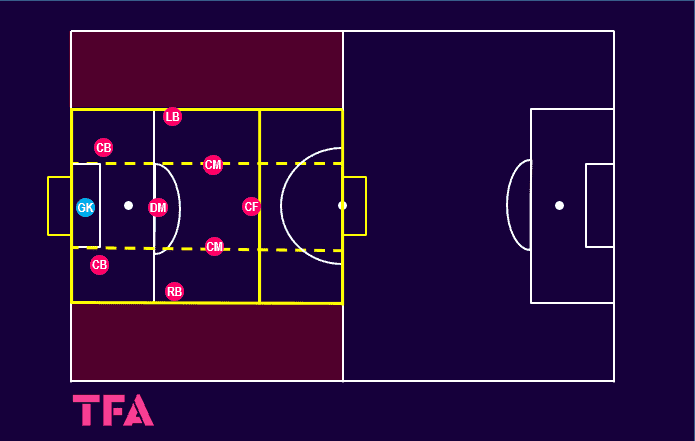
The above pitch diagram shows an example set-up for an 8 Vs 8 + GKs conditioned game. The practice area is condensed to half a field and the width of the box. Both teams set up in the same formation, shown as the pink team in the diagram above. How the teams set up when out of possession could be based on an upcoming opponent.
The width of the area being condensed to the width of the box forces the full-backs to remain inside the pitch and keep the wide-area empty. Often, a full-back’s tendency is to backtrack into the wide area to receive in more space. This practice is designed to make them feel more comfortable receiving under pressure in central areas. The size of the pitch taking this option away also prevents the coach from having to constantly remind the full-back to remain inside.
A progression for this conditioned game could be to add wingers (who could be neutral players playing for the in-possession team) and expand the pitch into the wide areas (highlighted red in the diagram).
Conclusion
The building block for any team implementing possession-based build-up play comes from the individuals within the team’s competence on the ball. Having the capability and confidence on the ball comes first. However, a well-organised structure and patterns of play help provide this confidence.
Players need to be put in match situations during training where they can work on this structure and problem-solve against different defensive set-ups. Postecoglou has discussed training against scenarios that they have not faced in recent games to keep the players primed for any situation they may face.
By consistently sticking with their style of play, regardless of the level of the opposition, Celtic learn in every game. This allows games to become a “practice”, aiding the constant improvement the Australian‘s team have had since he arrived. As the saying goes, you either win or you learn. Celtic almost always do both.






Comments